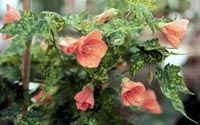Resource Library
Plant of the Week: Variegated Flowering Maple (Variegated Chinese Lantern Plant)
The University of Arkansas System Division of Agriculture does not promote, support or recommend plants featured in "Plant of the Week." Please consult your local Extension office for plants suitable for your region.
Plant of the Week
Variegated Flowering Maple
Latin: Abutilon hybridum 'Variegatum'

I like variegated plants. It probably indicates a weakness of character or a flawed
sense of taste, but I’ve always found them both beautiful and interesting.
One of the most interesting in the large tribe of variegated plants is the variegated
flowering maple, or as it is sometimes called, the variegated Chinese lantern plant.
It is a tender houseplant that grows 4- to 6 feet tall and has five-lobed maple-like
leaves with long petioles and grow 4 to 6 inches long.
This species is of hybrid origin with most of its kin coming from tropical countries
such as Brazil and Africa. It produces drooping, orange flowers in the shape of a
1950’s poodle skirt. The flowers grow to 1 1/2 inches across and have a short, yellowish
floral column extending just beyond the outer limits of the petals. The flowers can
be produced at any season, but mainly appear during the summer and fall when the high
light and warm temperatures are most to its liking.
We seldom intentionally grow sick plants, but that is exactly what we are doing when
we cultivate variegated Chinese maple. The variegation pattern consists of yellow-green
flecks scattered across the leaf surface creating a constellation of irregularly shaped
spots. The cause of the variegation symptoms is a mosaic plant virus called abutilon
mosaic, which can be spread to any non-variegated abutilon by either grafting or insects
– especially the pesky whiteflies.
Mosaic viruses are common among plants, but are usually more harmful and less beautiful
than this particular disease seems to be. Abutilon is vigorous enough to shrug off
the effects of the virus and still grow and flower more or less normally.
While the traditional use of flowering maples has been as a window sill plant for
winter flowering, it also makes an excellent addition to the mixed flower border where
its strong upright growth and yellow-green foliage makes an appealing foil for other
flowering plants.
As a houseplant it should have high light and be kept close to room temperature to
keep it growing and flowering. It, and many members of the hibiscus family to which
it belongs, is a magnet for whiteflies so should be checked carefully before bringing
it inside in the fall.
Propagation is easy, and can be done by cuttings or seeds. Seedlings will start off
uninfected and have normal green leaves. The virus can be transmitted by grafting
or allowing a few whiteflies to swarm from infected to noninfected plants.
By: Gerald Klingaman, retired
Extension Horticulturist - Ornamentals
Extension News - January 15, 1999
The University of Arkansas System Division of Agriculture does not maintain lists of retail outlets where these plants can be purchased. Please check your local nursery or other retail outlets to ask about the availability of these plants for your growing area.